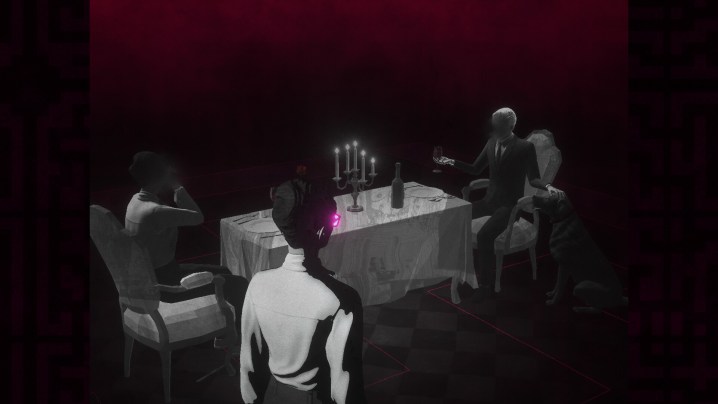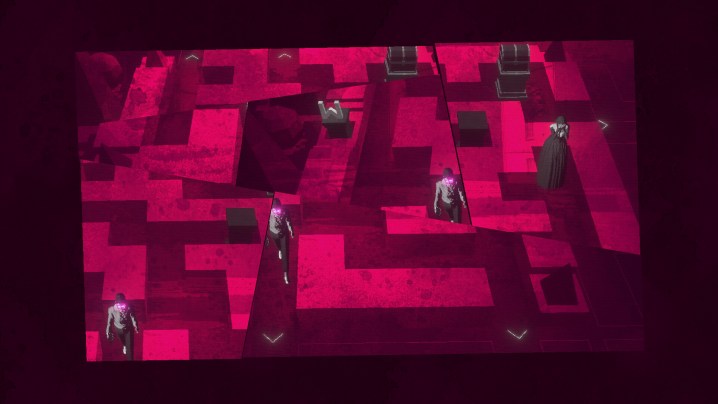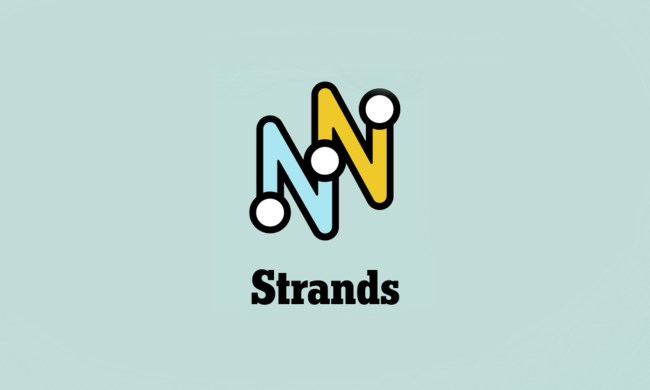- Ingenious puzzle design
- Consistently surprising
- Unnerving atmosphere
- Astonishing visual style
- Thematically rich
- Lack of hints may alienate some
I’m 15 hours into Lorelei and the Laser Eyes, the mysterious new game from Sayonara Wild Hearts developer Simogo, when I’m finally ready to tackle its ultimate puzzle. That time on my save file is misleading; I’ve likely spent closer to 100 hours getting there if you factor in all the sleepless nights where I laid awake trying to crack ciphers that eluded me. After all that mental work, I have almost everything I need to finally solve the labyrinth and find the truth behind a twisted mystery hiding in its center. But I’ve hit one final roadblock.
Five symbols. That’s all that stands in my way.
Early on during my stay at the gloomy Hotel Letztes Jahr, I discovered five odd shapes hidden throughout its rooms. They were abstract to me at the time, so I tucked them deep in my memory banks. Now everything depended on them. If I couldn’t deduce their meaning, I would be trapped here forever, clawing at a metal door that hid the answers I so desperately sought. The crowded notebook I’d been using through my playthrough to track clues begins to reach critical mass. I’m filling every free space with potential solutions.
“Maybe they form a word?” I try to rearrange them to form one coherent shape.
“This must be a number code!” I start seeing ones and sevens that don’t exist.
“Symmetry!” I flip my entire notebook upside down as I hit the brink of madness.
The more I scribble and rave, the further reality recedes into the distance. There’s one hard answer, but that hardly seems to matter to me anymore. I’ve tossed over a dozen hours of defined puzzle logic out the window. The act of personal interpretation has consumed my quest for the truth. I’m no longer trying to reconstruct a shattered mirror; I’m piecing together my own image in its shards.
That experience lies at the center of Lorelei and the Laser Eyes. Simogo’s cryptic adventure doesn’t just challenge players with intricately designed puzzles that are a devious delight to solve. It draws a parallel between the ways we deconstruct both fiction and reality, imposing our perspective onto both to try to make sense of that which we don’t understand. It’s a landmark work of interactive fiction that invites players to get lost in its labyrinth.
Alone in the dark
Though Lorelei and the Laser Eyes grapples with complex ideas, it’s a deceptively straightforward project deeply rooted in video game history. The story follows a woman who is invited out to a hotel to work on an eccentric Italian filmmaker’s new masterpiece. When she arrives, she’s roped into a series of compounding mysteries hidden throughout the hotel. Fact and fiction bleed into one another as she seeks to untangle a set of interweaving enigmas surrounding a mysterious artist whose work is displayed throughout the hotel.
The most painstakingly designed game I’ve ever played.
All of that plays out via classic puzzle box gameplay that calls back to foundational horror greats like Resident Evil and Alone in the Dark. Players are let loose in the totally open-ended hotel, tasked with solving its myriad of puzzles and finding documents that can make sense of the enigmatic story. It starts out simple enough; early puzzles have me dialing the correct numbers into padlocks based on telegraphed clues or taking keys to the correct door. That’s only the beginning of what may be the most painstakingly designed game I’ve ever played.
What’s so astonishing here is the intricate puzzle language Simogo has put together. Problems that seem downright impossible to solve feel like second nature once I return to them later armed with more knowledge about how puzzles work. Recurring clues like names and numbers help players build up a mental map of the maze. That opens the door for several “eureka!” moments that will have observant players feeling like a mastermind once they crack a seemingly obtuse solution. No problem is insurmountable in the Hotel Letztes Jahr, but some serious brainwork is required.
Lorelei and the Laser Eyes is less forgiving than your average puzzle game, even with its streamlined one-button control scheme. The puzzle formats are always changing. There’s no hint system. Most solutions can’t be brute-forced easily, save for some optional shortcut riddles. Anyone that does manage to luck themselves into the right answer by guessing will risk missing a crucial logic rule that could leave them lost later. Not a single word is out of place; even museum signs describing the hotel’s various sculptures may house secret clues. By the end of my playthrough, I knew every single detail about the world and its characters because of how carefully I pored over every single scrap of text I could find.

The payoff for that work is indescribably euphoric. Midway through my playthrough, I found myself bottlenecked by a single puzzle I’d put off that I needed to solve to progress. It revolved around a room full of busts, each of which had a nonsensical plaque underneath it containing a string of letters and numbers. Days went by. I simply couldn’t crack their secret code, which I’d need to type into a nearby computer. I pondered the answer every night as I fell asleep to no avail. One morning while showering, I was suddenly struck with an unexpected bolt of lightning. In a matter of 20 seconds, I figured it all out. I wasn’t even thinking about the game at that moment; that’s how deep it had its hooks in my subconscious mind.
In a note sent to the press, Simogo says that it doesn’t expect most players to finish the entire game. That seems to be by design. It wants to mislead players and send them down dead ends. That’s the thrill of a maze, after all. The tension arises when you completely lose your sense of space and start fearing that you’ll never make it out. That’s the uneasy feeling that Lorelei and the Laser Eyes evokes — and that makes it all the more satisfying whenever you do make a correct turn.
Amazing aesthetic
Lorelei and the Laser Eyes doesn’t explicitly advertise itself as a horror game, but it firmly belongs in that genre right alongside the classics it references. It’s a positively eerie adventure that dips into quiet psychological horror. Aside from one true jump scare (a pulse-raising nod to the original Resident Evil’s best thrill), Simogo is more committed to creating a tangibly uneasy ambiance that’s stuck with me long after finishing it all. That’s immediately apparent in its mesmerizing black-and-white art style, occasionally punctuated with blood-red accents that stain its world.
Twists add consistent surprises to the unpredictable adventure.
Like its meticulously built puzzles, nothing about the aesthetic is done without intention. The stark visuals call back to the Italian arthouse cinema of the 1960s, a touchpoint that’s central to decoding its thoughts on artistic interpretation. Its fixed camera angles, on the other hand, are yet another ode to the early Resident Evil era that subconsciously builds its tension. History isn’t just set dressing here; it’s as key to the text as the scattered newspaper clippings and journals.
Simogo gleefully explores that idea in Lorelei’s most self-reflective visual moments. One puzzle chain has me diving into playable prototypes for an original PlayStation-era horror game — complete with clumsy tank controls. By grabbing optional cash hidden around the hotel, I can buy a trio of games for a Game Boy-like device, one of which reimagines Lorelei and the Laser Eyes as a Super Pac-Man-style game. Those twists add consistent surprises to the unpredictable adventure, but they also seek to map out the evolutionary chain connecting video game history.

While the connection to ’90s horror games is Lorelei’s most obvious touchpoint, its callbacks connect the dots even further. Strip both Lorelei and Resident Evil down and you’ll realize that both are evolutions of the “maze game” genre at their core. They’re both about navigating claustrophobic spaces in search of an exit. You can connect them back to foundational games like 3D Monster Maze, another piece of history that gets a memorable visual nod. Lorelei and the Laser Eyes doubles as a retrospective of that artistic lineage, drawing a link between past and present.
A matter of perspective
If it sounds like my thoughts are wandering, you’re right. I find myself clutching at every piece of the game I can grab and connecting meaning to it. Perhaps some of it sounds like a stretch; an overeager attempt to understand an impenetrable mystery. There’s a reason I’m doing that, though; Lorelei and the Laser Eyes is about that experience.
Art, and the way we engage with it, is a major focus of the twisted story. The Italian filmmaker who sets the entire thing into motion is an avant-garde auteur (not too far off in design and attitude as 8 ½’s Guido Anselmi) who believes art should be challenging. “Money is to art like the black plague is to baby seals,” he tells me at one point, ranting about how commercialism is suffocating art. He wants his work to antagonize viewers more than entertain them, a philosophy that Simogo infuses into the game itself with its refusal to help players through hard puzzles. When I got stuck on the five-symbol puzzle I mentioned at the start of this review and asked the PR team representing it for a little help, Simogo sent back a vague clue that almost felt like it was forced out of the team.
The puzzle-box adventure is a quest for truth.
Lorelei and the Laser Eyes demands interpretation from its audience, both to grasp its mysterious story and its complicated puzzles. That’s best exemplified in the art of its titular character, Lorelei Weiss. All that we know about Lorelei early on is that she’s a prolific visual artist who is obsessed with perspective. The hotel is a living retrospective of her career — just as Lorelei the game is a retrospective of game history. Her most striking work is at the center of the game’s best series of puzzles, as players need to decode ciphers hidden within her sculptures. Those works aren’t just clever puzzle solutions; they remind the audience that their perspective is part of the work. They’re just objects collecting dust in a gloomy hotel until someone ascribes meaning to them.
“Art is only as good as its spectators,” a character tells me.
But this isn’t just a self-important piece of art about making art. Those meditations seep into a more poignant takeaway. The narrative doubles as a biography of Lorelei, a story that’s difficult to extract from the fiction surrounding it at times. With so many gaps left in her life, like pages ripped from a biography, I can only make up my own version of who she was and what happened to her.
As I try to piece it together, I’m brought back to the Oscar-winning Anatomy of a Fall, a film about an author accused of murdering her husband. The film never explains if she actually did it. Instead, her life becomes a work of avant-garde art for lawyers and the general public, both of which try to spin their own version of the truth out of their interpretation of hard facts. The way we warp reality in an attempt to understand it isn’t so far off from how we critique art.

Through that lens, the physical and metaphorical mazes at the heart of Lorelei and the Laser Eyes become more poignant. The puzzle-box adventure is a quest for truth. It’s my job to find out who Lorelei Weiss actually is. Every time I project my own interpretation of what I know onto her, it’s like I’m taking the wrong turn in a labyrinth. There’s joy in getting lost and exploring, but there’s one defined path through it — just as every puzzle I solve here has a single solution, no matter how many ways I try to reconstruct abstract symbols.
That’s the reward at the center of the maze: the real Lorelei Weiss. It’s like searching for a video game’s source code, the raw data that explains how the thing works in unquestionable terms. Perhaps that’s why Simogo seems so comfortable with the idea that most players may never hit the final credits. To see the end is to demystify a cold, hard truth. There’s nothing left to interpret. Maybe it’s more fun to stay lost, forever living in the mazes of fiction we build around fact.
Lorelei and the Laser Eyes was tested on PC and Steam Deck.





